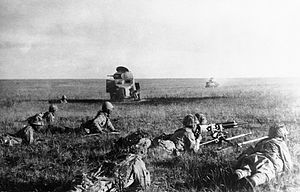
Back معركة خالخين غول Arabic Xalxin-Qol döyüşü Azerbaijani خالخین گول ساواشی AZB Баі на Халхін-Голе Byelorussian Битка при Халхин Гол Bulgarian Batalla de Khalkhin Gol Catalan Bitva u řeky Chalchyn Czech Slaget ved Khalkhin Gol Danish Μάχη του Χαλχίν Γκολ Greek Batalo de Halhin Gol Esperanto
| Battles of Khalkhin Gol/Nomonhan | |||||||||
|---|---|---|---|---|---|---|---|---|---|
| Part of the Soviet–Japanese border conflicts (until 1939) and World War II | |||||||||
 Japanese infantrymen near wrecked Soviet armored vehicles, July 1939 | |||||||||
| |||||||||
| Belligerents | |||||||||
|
| |||||||||
| Commanders and leaders | |||||||||
| Strength | |||||||||
|
61,860–73,961[nb 1]
4,000 trucks[7] 1,921 horses and camels (Mongol only)[8] |
~30,000-75,000(includes Manchu forces)[9][10][11][12]
1,000 trucks[14] 2,708 horses[15] | ||||||||
| Casualties and losses | |||||||||
|
Manpower: 752-2,276 noncombat[nb 2] Equipment: 208 aircraft lost[19] 253 tanks destroyed or crippled[20] 133 armored cars destroyed 96 mortars and artillery 49 tractors and prime movers 652 trucks and other motor vehicles[16][18] significant animal casualties[21] |
Manpower: 2,350 noncombat Equipment: 162 aircraft lost[19] 29 tanks destroyed or crippled[13] 7 tankettes destroyed 72 artillery pieces (field guns only)[23] 2,330 horses killed, injured, or sick[15] significant motor vehicle losses[24][page needed] | ||||||||
Location within Mongolia | |||||||||
| Events leading to World War II |
|---|
The Battles of Khalkhin Gol (Russian: Бои на Халхин-Голе; Mongolian: Халхын голын байлдаан) were the decisive engagements of the undeclared Soviet–Japanese border conflicts involving the Soviet Union, Mongolia, Japan and Manchukuo in 1939. The conflict was named after the river Khalkhin Gol, which passes through the battlefield. In Japan, the decisive battle of the conflict is known as the Nomonhan Incident (ノモンハン事件, Nomonhan jiken) after Nomonhan, a nearby village on the border between Mongolia and Manchuria. The battles resulted in the defeat of the Japanese Sixth Army.
- ^ Kotelnikov 2010, p. 109.
- ^ a b c d "Khalkhin Gol Battle: the Revision of Statistics". Archived from the original on 18 February 2017. Retrieved 25 February 2021.
- ^ Krivosheyev 1993, pp. 71–2.
- ^ a b Suvorov, Viktor (2008). The Chief Culprit (hardcover ed.). Naval Institute Press. p. 119. ISBN 9781591148388.
- ^ Zaloga 2007, p. 13.
- ^ a b V. Kondratiev, "Khalkhin Gol: War in the Air" retrieved 3 Jan. 2016
- ^ Coox 1985, p. 580.
- ^ "The Khalkhin Gol Battle, 1939" Retrieved 3 Jan. 2016
- ^ Bellamy, Christopher D.; Lahnstein, Joseph S. (1990). "The New Soviet Defensive Policy: Khalkhin Gol 1939 as Case Study". Parameters. 20 (1): 24. Retrieved 25 February 2021.
- ^ Cite error: The named reference
Gauthier2016_87was invoked but never defined (see the help page). - ^ The cited source here describes Japanese forces after the assault on the Soviets as numbering 28,000 men, and includes Manchu forces. For more information, see the "Aftermath" section.
- ^ Коллектив авторов. Россия и СССР в войнах XX века: Потери Вооружённых Сил / Под общ. ред. Г. Ф. Кривошеева. — М.: ОЛМА-ПРЕСС, 2001. — С. 177. — (Архив). — 5000 экз. — ISBN 5-224-01515-4.
- ^ a b Zaloga 2007, p. 14.
- ^ Coox1985, p. 563.
- ^ a b Coox 1985, p. 1168.
- ^ a b M. Kolomiets "Boi u reki Khalkhin-Gol" Frontovaya Illyustratsia (2002)
- ^ Sokolov, Boris (9 February 2015). "Халхин-Гол". www.slavic-europe.eu (in Russian).
- ^ a b "Soviet Losses in the Khalkhin Gol Battle". RKKA in World War II – Russian Project. Retrieved 21 July 2015.
- ^ a b Кондратьев В. Халхин-Гол: Война в воздухе. — М.: Библиотека журнала "Техники – Молодежи". Серия "Авиация", 2002. — 64 с. Тираж 1000 экз.ISBN 5-88573-009-1.
- ^ According to "Soviet Losses in the Khalkhin Gol Battle", these losses break down as: 30 BT-7s, 27 BT-7RTs,2 BT-7As, 127 BT-5s, 30 BT-5RTs, 8 T-26s, 10 KhT-26S, 2 KhT-130S, and 17 T-37s. This does not include tanks that only sustained light to moderate damage, or ones lost due to mechanical failure.
- ^ Coox 1985, p. 576. During one Japanese counterattack alone on the 12/13 August the MPR 8th cavalry division lost 100 horses captured.
- ^ Glantz, David M.; House, Jonathan (1995). When Titans Clashed: How the Red Army Stopped Hitler. Lawrence KS: University Press of Kansas. p. 14. ISBN 0-7006-0899-0.
- ^ Coox 1985, p. 987, includes 28 120mm–150mm guns and 44 75mm guns.
- ^ There are multiple accounts of Japanese trucks being knocked out by Soviet artillery and aviation, as well as losses due to mechanical failures or environmental hazards. Coox 1985.
Cite error: There are <ref group=nb> tags on this page, but the references will not show without a {{reflist|group=nb}} template (see the help page).
© MMXXIII Rich X Search. We shall prevail. All rights reserved. Rich X Search

